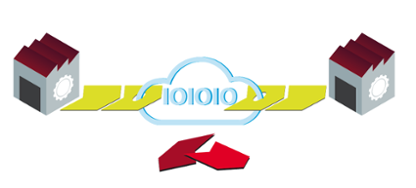Should You Make Supply Chain Forecasts in Excel?
Jesse Kelber - December 26, 2019

 Industry 4.0 technology is making its impact felt all along the supply chain as we enter the third decade of the 21st-century. Alongside IoT sensors, GPS trackers, smart pallets, and robotic picking technology, the progress made in supply chain management software has been unstoppable. Whereas once Excel sufficed to layout a strategic plan and track forecasting, today this method is becoming increasingly outdated and outpaced by more collaborative options. These new systems allow for real-time updates and enable real-time collaboration on planning documents by multiple stakeholders at the same time.
Industry 4.0 technology is making its impact felt all along the supply chain as we enter the third decade of the 21st-century. Alongside IoT sensors, GPS trackers, smart pallets, and robotic picking technology, the progress made in supply chain management software has been unstoppable. Whereas once Excel sufficed to layout a strategic plan and track forecasting, today this method is becoming increasingly outdated and outpaced by more collaborative options. These new systems allow for real-time updates and enable real-time collaboration on planning documents by multiple stakeholders at the same time.
There are five general pillars upon which a solid planning and forecasting infrastructure should be built: integration, transparency, flexibility, documentation, and collaboration. There will, of course, be overlap among these factors, since in many ways each one helps to enable the others. But when all five are covered you can begin to see the true power of an industry 4.0-based SCMS solution at peak power—enabling accurate, timely, and actionable forecasting. And it’s with those accurate forecasts that you can save time, energy, and money up and down your value chain.
Integration Is Key to Transparency—And Vice-Versa
When you decide it’s time to ditch Excel, the best place to look is toward a supply chain management system (SCMS). Perhaps the primary selling point of these all-in-one SCMS solutions is interoperability. With each module being fully integrated and available from a single dashboard interface, your inventory, production, and logistics systems are all able to play nicely with one another. The real-time data sharing in systems like this ensures that your forecast is fully informed by the latest information from each end of the chain and can combine that with the information coming in from the factory floor to produce that incredibly accurate forecast you’ve been looking for. Thus, high levels of integration and transparency between systems help you ensure your analytics have the data they need—the up-to-the-minute data flowing in from the floor—to combine with your historical data to produce that forecast.
Information Silos Kill Flexibility
Even if your primary Excel forecast is stored in the cloud where the right people can get to it, you still don’t have a truly flexible planning process. This is mainly due to the single-access nature of a traditional spreadsheet. If you have the file open to update it, your logistics coordinator can’t get in to grab that piece of info they need when the trucks show up. Your inventory manager, who may need to know where to stash that order that just arrived? They can’t get in either. Now there’s time being wasted on both ends, which makes your workflow the opposite of agile. When these two stakeholders decide to download copies of the static file, so they can at least open that version when they need it, suddenly the most recent information becomes siloed with you. Add to that any changes made by either party and that information is now siloed with them. Either way, 2 out of 3 of you do not have the updated information you need to do your best work. And the whole chain will potentially suffer because of these data silos.
Real-time Forecasting Benefits From Real-time Documentation
The most accurate possible forecast requires each involved party, including your SCMS tools themselves, to have the most up-to-date information possible. And that means updated documentation for each step along the way. It also means current sensor readings, up-to-the-minute data flows, and the ability for all of these parties to be able to access that data exactly when they need it. For that to happen, documentation must be current at all times. A single Excel spreadsheet file on your desktop does not meet this requirement. On the other hand, a robust SCMS will have the ability to take in the data flow from the sensors up and down the supply chain, input the data received into the relevant files and spreadsheets, and make those files available to whoever needs them, instantly. If you already have the IoT sensors and other Industry 4.0 tech in place in your organization but are still trying to use Excel for documentation, your forecasts are going to suffer until you get the rest of your systems updated and in sync.
Accuracy in Forecasting Requires Collaboration...
The gains made above won’t amount to much if all stakeholders aren’t able to work on the same files, maintaining the same information store across departments. And here we’re referring to the ability to access and modify the same files, at the same time, and work together to ensure they’re complete and up-to-date. No matter how advanced your IoT sensors, how fast your data flow, or how powerful your AI-powered advanced analytics, if you and the inventory manager can’t collaborate on files neither of you will be able to take advantage of all that technology fully. It’s only when those analytics engines have the most current data from the field, at the same time you and the inventory manager can make tweaks and updates, that you’ll be able to produce the most accurate possible forecasts.
...And Collaboration Requires Access
We’re coming full circle, back to the simple underlying fact that a single Excel spreadsheet cannot be accessed by multiple parties at the same time. When you, as the production planner, have the forecast file stored on your desktop, how can your inventory and logistics divisions know what’s going on? With a central datastore, you can allow each stakeholder to access exactly the data they need, the files they require, and the documentation they need in order to do their jobs at peak efficiency. As one user updates the data, their collaborators (and the analytics engine) can assist with refining their expectations. Then this system of stakeholders and analytics can work to visualize the potential capacity planning scenarios. When every stakeholder can be working from the same file, seeing every update and change in real-time, that’s when you can realize the goal of the most accurate forecasts ever possible. All that with no Excel files in sight.
LATEST POSTS
- Understand Circular Economy in The Manufacturing Industry
- How Can Industry 4.0 IT Integration Be Achieved Smoothly?
- The Significance of Order Sequencing in Discrete Manufacturing
- How to improve your Supply Chain Management: The Power of Control Towers
- Optimizing Human Resource Scheduling in Manufacturing: A Technological Approach


